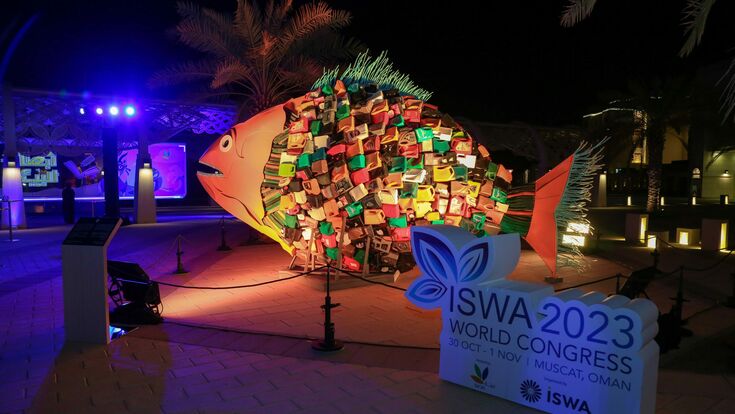#ISWA2023 : ISWA World Congress: Day 1 Recap

The first day of this years ISWA World Congress, hosted by be’ah, the Oman Environmental Services Holding Company, in the country’s capital Muscat, started with engaging keynotes, interesting presentations and lively discussions. In his keynote address Simon Baptist, Global Chief Economist at The Economist Intelligence Unit in Singapore talked about the role of the waste and resources management sector in a global economy: “Physical materials have never been more important for the global economy. Rising and volatile prices suggest increasing resource constrained and value over time, with geopolitical concerns about supply chains adding to the focus,” he said. “Waste management has an important role to play in today’s economy, and that’s even before adding environmental and sustainability factors.”
In the afternoon, four concurrent sessions focused on protecting human health and the quality of the environment, mitigating climate change, driving resource efficiency and the circular economy as well as new technology adoption and sector transformation towards a circular economy.
Here are some highlights of the day. In her presentation about environmental monitoring at Ämmassuo Waste Treatment Center in Finland – the largest of its kind in the Nordic countries – Linda Röman focused on landfill after care. She stressed that according to law at least 30 years must be reserved for the after care. Among the monitoring activities necessary – such as noise, pest control, harmful invasive species and littering – water management is one if not the most important part of after care. The centralised monitoring system at Ämmassuo Waste Treatment Center covers all waters. Wastewater is conveyed to a near wastewater treatment plant. Samples are taken regularly also from the various lakes and streams around site to guarantee water quality.
Röman also talked about so called micrometeorological measurements. This method provides information of the quantity of landfill gas generated from organic waste and its distribution between methane and carbon oxide. The presentation was followed by a lively discussion. Generally, the audience on that day was quite animated, engaging with the presenters, asking questions, voicing their opinion. Especially during the panel discussion “Transitioning from dumpsite operations into integrated sustainable waste management” held by the Working Group on Landfills & Closing Dumpsites Task Force.
“How are you going to close the dumpsites?” and “What are you going to do then?” – according to panel moderator and ISWA’s Technical Director Aditi Ramola those are the most asked questions when talking about closing dumpsites. So the panel tried to give answers to that and also to the question: “Is this a viable business case?”
Chair of the Working Group on Landfills James Law stressed that there are a number of challenges: “The Number 1 challenge: There are informal recyclers present. Because, and I hate to say this, but there will be somebody killed on the dumpsite,” Law said in his opening remarks. “Also dumpsites are always catching fires.” He then engaged the audience, who added gas emissions, contamination, odours, landslides, littering and animals eating the waste to the list.
Masood Mallick, CEO of Indian company Re Sustainability, then focused on how to approach a dumpsite. “First you have to diagnose the problem”, he said. “Landfills develop over decades. Luckily there are now intrusive and non-intrusive methods to analyse a landfill or dumpsite to know about the characteristics and composition.” But: “What you see is just the tip of the iceberg. What you don’t see, what is under the dumpsite, what is around it, is of more interest. That is where the real health risk it.” But you also need to know what to do with the land after cleaning up the dumpsite. “People get happy solving optical problems. But you might not have solved the real problem.”
Rene Rosendal, Vice Chair of the working group and senior project manager at AV Miljo and Partner Danish Waste Solutions, talked about biomining stressing that the political will to deal with dumpsites and landfills might be important but it is essential to change the system first. “Otherwise waste will end up in just another dump,” he said. Aditya Handa, founder and MD of Abellon Group, agreed and added: “Open dumps are caused by a bad waste management system.” Also, when talking about dumpsites,very often people focus on the best 30 per cent of waste they can get out. “But we need to ask: What can we do with the worst 30 per cent. You need to have a plan, be it an engineered landfill or energy recovery.”
James Michelsen of the International Finance Corporation (IFC) then spoke about financing dumpsite closing projects. “There is nothing in our sector that has this amount of social, environmental and economic impact. But you need to understand each dumpsite on its own. Risk based approach. Regulations and some kind of enforcement needs to be in place.” During the following discussion, he added that the cleaning and extraction does not pay for itself. “But if you have an option for the land you treated, then you can make money.”
Asked what is needed to get the private sector interested, Mallick Masood pointed at the plethora of regulations and definitions of sustainable waste management: “Make it consistent”, he said. “Even if it is bad – at least it is consistent.”
Plastic pollution and marine litter not only poses a threat to our oceans and ecosystems but also the overall health of our planet. So a diverse group of stakeholders joined forces to form the Community of Action against Plastic Pollution presented in a special focus session. They not only want to raise awareness of the problem plastic pollution poses but also the showcase success stories and highlight best practices. The CLOCC project (Clean Oceans for Clean Communities) is such a one. So far the project is active in India and Indonesia where it helps set up sustainable waste management systems with the local stakeholders.
